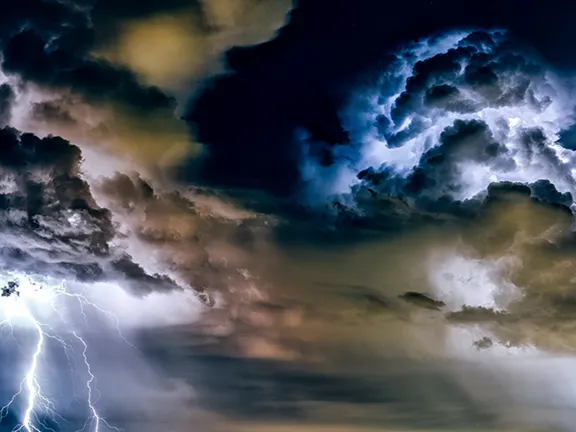Climatic Events that Changed the World
Climatic Events and Civilisations over the last 4000 years
Over the last 4,000 years, several civilizations have experienced collapse or significant decline coinciding with notable climatic events. It is important to note that societal collapses are rarely due to a single factor, and climate change often interacts with other stresses like social unrest, resource depletion, and conflict.
By Nick Nutter on 2025-05-24 | Last Updated 2025-05-24 | Climatic Events that Changed the World
This article has been visited 1,733 times

Volcanic eruptions can disrupt weather patterns
Six Civilisations Affected by Climate Change Events
Let us, briefly, look at six societies or civilisations whose demise was at least partly due to climate change over the last four thousand years or so.
Akkadian Empire (c. 2350-2100 BC)
The collapse of the Akkadian Empire in Mesopotamia is strongly linked to a severe and abrupt drought event around 4,200 years ago, (known as the 4.2k yr BP event - 2200 BC). This megadrought, lasting for several centuries, led to widespread agricultural failure, famine, and social instability, contributing to the empire's downfall. Evidence includes windblown silt layers in archaeological sites and paleoclimate data from marine sediments and cave deposits.
Indus Valley Civilization (Harappan Civilization) (c. 2500-1900 BC)
The decline of the Harappan civilization in present-day Pakistan and India is associated with significant shifts in monsoon patterns. Around 4,250 years ago, a reduction in winter rainfall led to an initial period of adaptation. However, around 4,000 years ago, a dramatic reduction in summer monsoon rainfall further impacted agricultural systems, leading to the abandonment of major cities and a shift towards more rural, pastoral lifestyles.
Classic Maya Civilization (c. 250-900 AD)
The collapse of the Classic Maya in the Yucatán Peninsula and Petén Basin is widely attributed to prolonged and severe droughts, particularly between 800 and 1000 AD. These "megadroughts" were some of the most severe in the last 7,000 years and critically impacted their rain-fed agricultural system, leading to food shortages, conflict, and societal disintegration.
Ancestral Puebloans (formerly Anasazi) (c. 300 BC - 1300 AD)
This civilization, in the American Southwest, experienced a significant decline and abandonment of major settlements, such as those at Mesa Verde and Chaco Canyon, coinciding with the Great Drought of 1276-1299 AD. While initially thought to be the sole cause, more recent research suggests it was exacerbated by other factors like deforestation, resource depletion, and possibly shifts in rainfall patterns that made agricultural practices less dependable. Some theories also suggest that the onset of the Little Ice Age (around 1300 AD) contributed, as lower elevations became too dry and higher elevations too cold for farming.
Angkor Civilization (Khmer Empire) (c. 800-1431 AD)
The capital of the Khmer Empire in Cambodia, Angkor, known for its elaborate water management system, faced significant challenges during the onset of the Little Ice Age (around 1300 AD). The region experienced extreme monsoons followed by prolonged periods of drought, leading to floods that damaged their infrastructure and droughts that strained food production. This climatic instability, coupled with other factors, is believed to have contributed to their decline.
Norse Settlements in Greenland (c. 985-1450 AD)
The Norse colonies in Greenland, established during the Medieval Warm Period (c. 900-1200 AD), faced severe challenges with the onset of the Little Ice Age around 1300 AD. As temperatures dropped, seas froze, growing seasons shortened, and vital resources became scarce, ultimately leading to the abandonment of the settlements by the mid-15th century.
Summary
These examples highlight how climate variability, particularly prolonged droughts or shifts in established rainfall patterns, can significantly stress societies, especially those heavily reliant on agriculture, and contribute to their eventual collapse. However, as you will appreciate, these notable ‘climatic events’ were localised, only affecting a part of the globe, leaving other parts unaffected or even, in some cases, better off weather wise.
Do you enjoy my articles? For your reading pleasure, this website does not carry third party ads. You could help me write more articles by buying me a cup of coffee.
The Little Ice Age
The Little Ice Age is often cited as being a ‘global’ event. More recent, less hysterical research shows a somewhat different pattern.
The Little Ice Age (LIA) was a period of regional cooling, particularly pronounced in the North Atlantic region (Europe and North America), rather than a globally synchronous "true ice age.”
Regional Variation
While often referred to as a global event, current scientific consensus emphasizes that the LIA was not uniformly cold across the entire planet at the same time. Different regions experienced their coldest temperatures at different points during the LIA's broad timeframe (conventionally defined as extending from the 16th to the 19th centuries, though some experts prefer 1300 to 1850). For example:
- Minimum temperatures hit the eastern Pacific in the 15th century.
- Northwestern Europe and southeastern North America saw their coldest periods in the 17th century.
- Many other regions experienced their minimums in the mid-19th century.
- Some areas, like eastern China, did not even experience significant cooling during the LIA.
Northern Hemisphere Focus
The most dramatic and well-documented effects of the LIA were in the Northern Hemisphere, especially in Europe and North America. This is where you find the most historical records of frozen rivers (like the Thames and canals in the Netherlands), expanding glaciers in the Alps, and impacts on agriculture and society.
Southern Hemisphere Evidence
There is evidence of increased glaciation and cooler episodes in the Southern Hemisphere, such as in parts of Antarctica, New Zealand, and Patagonia. However, the timing of these glacial advances often differed considerably from those in the Northern Hemisphere, suggesting they might represent independent regional climate changes rather than a globally synchronized event.
Causes and Complexity of the Little Ice Age
The LIA's causes were likely a combination of factors, including:
Reduced solar activity: Periods of low sunspot activity (like the Maunder Minimum) coincided with some of the coldest years in Europe.
Increased volcanic activity: Large volcanic eruptions can inject aerosols into the atmosphere, blocking sunlight and causing temporary cooling.8 Multiple such eruptions occurred during the LIA.
Changes in ocean circulation: Shifts in patterns like the North Atlantic Oscillation (NAO) are believed to have played a significant role in influencing regional climate, particularly in Europe.
Inherent climate variability: Natural fluctuations within the climate system itself also contributed.
Death Toll in Europe During the Little Ice Age
The Little Ice Age was responsible for millions of deaths over the course of 550 years due to starvation and related causes. Pinpointing exact numbers of deaths in specific European countries during the entire Little Ice Age (LIA) is incredibly challenging due to:
Lack of precise record-keeping: Reliable, widespread demographic data, especially for causes of death, simply didn't exist for most of the LIA's duration.
Intertwined causes of death: Malnutrition weakened populations, making them highly susceptible to infectious diseases (like typhus, influenza, and dysentery), which were often the immediate cause of death. Wars and social unrest also exacerbated famine conditions. Historians often refer to "hunger-related diseases."
Regional and temporal variability: Famines were often localized and episodic. A severe famine in one region might not affect another, and periods of extreme hardship were interspersed with more stable times.
The Great Famine of 1315-1317 (and extending to 1322)
This was one of the earliest and most devastating events that coincided with the very start of the LIA. It affected much of Northern Europe, including the UK, France, and parts of Germany.
Across Europe: Estimates suggest that 5-12% of the population of northern Europe died from starvation or related disease during this period. Some sources indicate a loss of 10-15% in the south of England and about 10% in Northern France.
Specific numbers for countries are difficult: While chronicles record severe hardship, food shortages, and cannibalism in places like Bristol (UK), and the French army struggling to find provisions, precise national figures for deaths are not available.
17th Century France (e.g., Famine of 1693-1694): France experienced particularly severe famines during this century. The catastrophic famine of 1693-1694 alone is estimated to have caused the deaths of 1.3 to 2 million people, which was roughly one-tenth of the French population at the time.
18th Century Europe (e.g., Famine of 1770-1772): This period saw widespread famine across Europe, impacting Germany and other central European states.
One estimate suggests that one million people died across Europe during the famine of 1770-1772, "more than in all the wars of the 18th century combined." This indicates significant mortality in countries like Germany, though specific national breakdowns for starvation deaths are scarce.
UK (England): While still suffering, England's system of local parish relief (a compulsory tax for the poor) is sometimes credited with reducing starvation deaths compared to France during some of the LIA's crises. However, severe winters like that of 1684 still "claimed many lives."
Summary
In summary, while the term "Little Ice Age" suggests a global phenomenon, it's more accurate to describe it as a period of increased temperature and precipitation variability across many parts of the globe, with particularly pronounced cooling and its associated impacts concentrated in certain regions, especially the North Atlantic. It was not a "true ice age" of global extent like the Last Glacial Period.
The following articles in the series look at climatic events between the Neolithic period and the end of the Bronze Age and how they variably affected the people living in and around the Mediterranean Basin.
Do you enjoy my articles? For your reading pleasure, this website does not carry third party ads. You could help me write more articles by buying me a cup of coffee.
 2: The 8.2k yr BP event
2: The 8.2k yr BP event 3: Creating the Sahara
3: Creating the Sahara 4: The 4.2k yr BP event
4: The 4.2k yr BP event 5: The 3.2k yr BP Event
5: The 3.2k yr BP Event